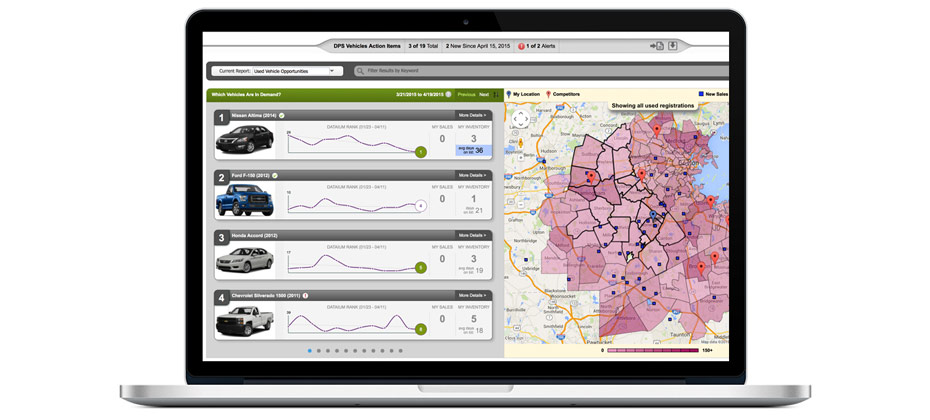Tag: Auto-AutoCheck

In the world of marketing, this can happen to all of us. We think we know how much ad spend we should put towards a PPC campaign or what time a TV ad should air. In this digital realm, dealers are given a lot of data when a campaign finishes. Technology has pushed our boundaries so now, someone looking at a video of a specific automobile on a social media platform like YouTube can be targeted to receive video advertisements for your dealership. With that said, how do you know if you are targeting the right people? When it comes to your campaigns, you want to know your money is going towards the right forms of advertisements as well as the right demographics. If a campaign is doing well, extending out that campaign can be a better decision compared to letting it end. On the other side, if a campaign is doing poorly, pausing or evening stopping the campaign can be more beneficial in the future. The big questions you must ask yourself are: Am I targeting the wrong people? There can be a few reasons why you may be targeting the wrong people. First, the type of campaign can be incorrect. Social media is the newest and hottest form of marketing, but that may not work with your audience. Second, your demographics may be off. Without knowing the key demographics that you are targeting, you could be blindly targeting customers not interested in your vehicles or not in the market. The opposite could be said for that as well. You may be leaving out potential customers in key geological areas around your dealership. Because of this, you could be losing sales. Targeting doesn’t just stop with humans. You must think about your location and what you have in your inventory. If you are in a state like Colorado, you will want to allocate more SUVs and vehicles that have all-wheel-drive. By advertising rear-wheel-drive or sports cars to individuals that exclusively drive SUVs or only research SUVs, that can be a loss of advertising dollars. What can I do about it? A revamped marketing campaign is a good start for a strategy, but it may not be enough. Targeting can be a difficult endeavor, but thankfully there are programs and companies that can help. Experian Automotive’s Dealer Positioning System® can target key ZIP Code™ and display which campaigns are working - as well as which should be cut. Thanks to this type of data-driven targeting, market share and sales can increase even while advertising spend decreases. Another great aspect of using a system like Experian DPS is the ability to create campaigns to target vehicles your customers want. Like the example above of what not to do, you can formulate a plan of attack to focus on SUVs and light-duty trucks in a mountainous area. Conquesting intelligently not only means more people coming through your door but more allocations for vehicles your customers will want. Marketing is important. Whatever kind of advertising you do, remember that building your dealership is important. Having a solid game plan to conquest around you relies on smart targeting and the correct forms of advertising. Experian DPS can help boost market share and increase sales core models which is very helpful. To learn more about how Experian Automotive can assist with your targeting, click here.

The auto industry has been riding a wave of prosperity for the past seven years, bouncing back nicely from the 2008 market collapse. But, it looks like rising sales of the past 10 years, are, well...a thing of the past. According to Alix Partners, 2016 sales of 17.5 million units might be the high-water sales mark, at least through 2022. Alix Partners says the next five years sales will range between 15.6 million to 16.8 million annually. Suddenly, it will be challenging for dealers to stay in strong growth mode. How can dealers best react to the tightening market? The Experian white paper “Data Tools Evolve to Give Dealers an Edge in a Tight Sales Market” takes a look at how new and improved data and analytic tools can provide deeper insights to help automotive retailers unlock sales. The paper reviews current market sales statistics, historical sales trends and how dealers reacted during similar market conditions in the past. In addition, the paper provides a look at the challenges faced by automotive retailers, in terms of shrinking gross profit, higher advertising expenses and increased competition. Automotive retailers also will find information on the importance of customer conquesting and a look at technology tools to help provide a deeper understanding and actionable intelligence about local markets. Data and analytics are no longer the private purview of large mega-dealers. The Experian white paper outlines today’s data tools that can be implemented quickly and cost effectively by dealers of any size. To learn more about these trends, download the paper here: https://www.experian.com/automotive/dealerwhitepaper.html

When discussing automotive lending, it seems like one term is on everyone’s lips: “subprime auto loan bubble.” There’s always someone who claims that the bubble is bursting. But a level-headed look at the data shows otherwise. According to our Q1 2017 State of the Automotive Finance Market report, 30-day delinquencies dropped and subprime auto lending reached a 10-year record low for Q1. The 30-day delinquency rate dropped from 2.1 percent in Q1 2016 to 1.96 percent in Q1 2017, while the total share of subprime and deep-subprime loans dropped from 26.48 percent in Q1 2016 to 24.1 percent in Q1 2017. The truth is, lenders are making rational decisions based on shifts in the market. When delinquencies started to go up, the lending industry shifted to more creditworthy customers. This is borne out in the rise in customers’ average credit scores for both new and used vehicle loans: The average customer credit score for a new vehicle loan rose from 712 in Q1 2016 to 717 in Q1 2017. The average customer credit score for a used vehicle loan rose from 645 in Q1 2016 to 652 in Q1 2017. In a clear indication that lenders have shifted focus to more creditworthy customers, super prime was the only risk tier to grow for new vehicle loans from Q1 2016 to Q1 2017. Super-prime share moved from 27.4 percent in Q1 2016 to 29.12 percent in Q1 2017. All other risk tiers lost share in the new vehicle loan category: Prime — 43.36 percent, Q1 2016 to 43.04 percent, Q1 2017. Nonprime — 17.83 percent, Q1 2016 to 16.96 percent in Q1 2017. Subprime — 10.64 percent, Q1 2016 to 10.1 percent in Q1 2017. For used vehicle loans, there was a similar upward shift in creditworthiness. Prime and super-prime risk tiers combined for 47.4 percent market share in Q1 2017, up from 43.99 percent in Q1 2017. At the low end of the credit spectrum, subprime and deep-subprime share fell from 34.31 percent in Q1 2016 to 31.27 percent in Q1 2017. The upward shift in used vehicle loan creditworthiness is likely caused by an ample supply of late model used vehicles. Leasing has been on the rise for the past several years (and is at 31.06 percent of all new vehicle financing today). Many of these leased vehicles have come back to the market as low-mileage used vehicles, perfect for CPO programs. Another key indicator of the lease-to-CPO impact is the rise in used vehicle loan share for captives. In Q1 2017, captives had 8.3 percent used vehicle loan share, compared with 7.2 percent in Q1 2016. In other findings: Captives continued to dominate new vehicle loan share, moving from 49.4 percent in Q1 2016 to 53.9 percent in Q1 2017. 60-day delinquencies showed a slight rise, going from 0.61 percent in Q1 2016 to 0.67 percent in Q1 2017. The average new vehicle loan reached a record high: $30,534. The average monthly payment for a new vehicle loan reached a record high: $509. For more information regarding Experian’s insights into the automotive marketplace, visit https://www.experian.com/automotive.

Today is a great day for Experian and our automotive clients. We’ve been working with String Automotive for several years, and have now taken the next step in our relationship, as String Automotive has become part of the Experian family. In today’s generally flat new-car market, successful dealers need the perfect mix of data and market intelligence to drive more sales, cultivate deeper customer relationships and develop new ways of better conquesting customers from their competition. String Automotive’s Dealer Positioning System, matched with our own information and data-driven insights, provides our automotive dealer clients with an ideal solution to grow their businesses. It is the only platform to combine dealership website analytics and inventory information with automotive market, consumer demographic and purchasing behavior data. Simply put, it takes the pulse of each dealership’s local market and guides dealers to make the most profitable, proactive decisions for every store and unique situation. This powerful analytics solution simplifies choices like how to spend marketing dollars and where to target conquesting efforts by letting market and dealership data drive decisions. What’s the bottom line? The Dealer Positioning System increases profitability across the dealership. It’s one thing to hear that message from us, but we also hear of the benefits from our clients. Paul Schnell, digital marketing director at Wilsonville Toyota in Oregon, had this to say: "There is no 'I wonder if...' with the Dealer Positioning System®. Now it is, 'I know it and I can act on it today’. Their latest tools give us zip-code-level intelligence that's just not available at the dealer level any other way. We are micro-targeting the perfect message with the perfect vehicle to the perfect prospect." For more information on Experian or our other automotive products and services, please visit www.experian.com/automotive. For more information about String Automotive and the Dealer Positioning System, please visit http://stringautomotive.com/Dealer_Positioning_System.

With steady sales growth the past several years, the auto industry has had a great run since the trough of the Great Recession in 2009. Based on the latest data published in the State of the Automotive Finance Market report, the auto industry’s robust sales totaled more than 17 million vehicles in 2016, pushing the total open auto loan balances to a record high of $1.072 trillion, up from $987 billion in Q4 2015. Despite the current boom, new vehicle affordability is becoming more challenging. The average monthly payment for a new vehicle loan jumped from $493 in Q4 2015 to $506 in Q4 2016, while the average new vehicle loan reached an all-time high in Q4 2016, at $30,621. In addition, the chasm between new vehicle loan and used vehicle loan average amounts is wider than ever at $11,292. This trend appears to be pushing more credit-worthy customers into the used vehicle market. In Q4 2016, the percentage of used vehicle loans going to prime and super prime customers was up from 45.49 percent in Q4 2015 to 47.76 percent in Q4 2016. In addition, the average credit score for used vehicle loans is up from 649 in Q4 2015 to 654 in Q4 2016. Consumers also appear to be combating the vehicle affordability issue by shifting into leases or longer-term loans to keep their monthly payments low. Leasing was up from 28.87 percent of all new vehicle financing in Q4 2015 to 28.94 percent in Q4 2016. Loan terms of 73 to 84 months now account for 32.1 percent of all new vehicle loans, up from 29 percent in Q4 2015. Keeping payments manageable will help keep people out of delinquencies, which is good for consumers and their lenders. Data shows that 30-day delinquencies were relatively flat, moving from 2.42 percent in Q4 2015 to 2.44 percent in Q4 2016, while 60-day delinquencies are growing, moving from 0.71 percent to 0.78 percent. It seems that as long as new vehicle costs rise, it is likely that more people will move toward leasing, longer term loans and used vehicles. While none of these trends are inherently bad, they could re-shape dealer strategy moving forward. Many analysts predict flat new vehicle sales in 2017, making used vehicle, F&I and service business more important to overall dealership growth this year.

The auto industry has had an impressive recovery from the Great Recession and has enjoyed steady growth for the past seven years. After bottoming out in 2009 at 10.5 million new vehicle registrations, the industry has grown each year since, culminating in 17.3 million new vehicle registrations in 2016. However, the rate of growth has been slowing over the past several years, increasing just 1.03 percent from 2015 to 2016. While retail registrations were nearly flat, the growth came from fleet, with a 13.69 percent spike in registrations by government entities and a 5.59 percent increase in commercial/taxi registrations. When automotive sales growth begins to taper, hanging onto existing customers becomes more important than ever. Fortunately, customer loyalty in the auto industry is rising for manufacturers, dealers and lenders. The manufacturer loyalty rate through November 2016 was 62.8 percent, up from 59 percent in 2010. At the make level, the loyalty rate went from 50.6 percent in 2010 to 54.5 percent through November 2016. Loyalty to a specific dealer is significantly lower but still on the rise, moving from 19.5 percent in 2010 to 23 percent through November 2016. Interestingly, 61.3 percent of all new vehicle registrations in 2016 were to customers 45 years old and older. Manufacturers and dealers who can keep these customers in the fold in the next several years are likely to maintain and grow their overall share. Our recent analysis also looked as how age impacts vehicle purchasing loyalty. In general, older customers tend to be more loyal than younger customers. Manufacturer loyalty rates by age include: 18-24 years old – 58.3 percent 25-34 years old – 55.4 percent 35-44 years old – 59.9 percent 45-54 years old – 64.4 percent 55-64 years old – 68.2 percent 65+ years old – 70.4 percent General Motors market share still number one For manufacturer market share in 2016, General Motors led the way at 16.91 percent. However, this is a significant drop from the 24 percent share of total vehicles in operation (VIO) enjoyed by GM. Toyota was second in manufacturer market share at 15.46 percent, followed by Ford Motor Co. at 12.59 percent and FCA US at 11.77 percent. Honda rounded out the top five manufacturers at 11.19 percent. For manufacturer customer loyalty, however, Tesla came out on top at 73.6 percent, followed by Toyota at 68.7 percent and Subaru at 66.8 percent. Ford and GM round out the top five at 65.7 percent and 64.7 percent respectively. Pickup trucks claim top model share, loyalty rankings Pickup trucks again held the top two positions among the most popular vehicles, with the Ford F-150 at 3.06 percent and the Chevy Silverado at 2.61 percent. Honda claimed the next three spots with the Honda Civic (2.53 percent), the Honda CR-V (2.46 percent) and the Honda Accord (2.37 percent). While the F-150 and Silverado were the most popular models, their competition led the way in customer loyalty. The Ram 1500 full-size pickup truck had a customer loyalty rate of 50.9 percent, followed by the F-150 at 46.3 percent and the Lincoln MKZ at 43.9 percent. In other trends: Non-luxury small CUV/SUVs were tops in segment market at 17.81 percent, followed by non-luxury mid-size sedans (13.89 percent) and non-luxury mid-size SUVs (13.22 percent). Tesla led the industry with a Conquest/Defection ratio of 13.77 to 1. 4-cylinder engines overtook 6-cylinder engines as the top engine type, 38 percent to 37.4 percent Vehicles in Operation are expected to reach 292 million by 2020 For more information on how to drive customer loyalty rates, visit Experian Automotive.

If you listen to some of the latest auto industry analysis, you might get the impression that the industry is doomed because younger consumers aren’t interested in buying cars. It is true the vast majority – 61.3 percent – of new vehicle registrations in 2016 were from customers 45 years old and older, but is that really a cause for concern? Or are automotive marketers simply doing a better job of identifying customers with the means to buy their product? Remember Willie Sutton’s response when asked why he robbed banks? “Because that’s where the money is.” Maybe, just maybe, automotive marketers are getting better at market segmentation and finding the right customers for their vehicles. Maybe, they’re simply going to “where the money is” like Willie Sutton. How do auto marketers know where to look? Experian’s Mosaic® USA consumer lifestyle segmentation is a good place to start. It is made up of 71 different consumer groupings from the most affluent suburbanites to the most economically challenged. Understanding who and where these customers are and knowing which vehicles fit their current lifestyles and economic standing can help automakers and retailers boost sales. Take luxury vehicles, for example. In Q4 2016, the top three Mosaic® consumer segments in the luxury vehicle category included: American Royalty – 12.67 percent Silver Sophisticates – 7.69 percent Aging in Aquarius – 5.01 percent Who are these folks? Individuals and households in the: American Royalty include wealthy, empty nest Baby Boomers with million dollar homes; Silver Sophisticates include a mix of older and retired couples and singles living in suburban comfort; and Aging in Aquarius include empty-nesting couples between 50 and 65 years old with no children at home who are finally enjoying the kick-back-and-relax stage of their lives. What do each of these segments have in common? Their members have the disposable income to pamper themselves a bit, and a luxury vehicle might just be the way to do it. But, what if you sell minivans? The Mosaic consumer segment Babies and Bliss is one target audience to consider targeting. These large families with multiple children live in homes valued over $250,000 and should be at the top of your prospecting list. How about those younger customers who seem so anti-auto? Fast Track Couples -- families on the road to upward mobility, under the age of 35, with good jobs and own their homes are ripe for a CUV. Or perhaps Status Seeking Singles -- younger, middle-class singles preoccupied with balancing work and leisure lifestyles? There’s got to be a hybrid vehicles waiting for them, right? Just because younger customers are still in the minority of auto buyers, it doesn’t mean the industry is in crisis. The right customer segment for the right vehicle is out there – even in the younger demographics. And besides…younger customers get older so now is the time to win their hearts and minds and begin building a long-term relationship with them. But, if you’re not the patient type and you’ve got a vehicle to sell, you can find your next best customer by using Mosaic USA to create cross-channel messaging that connects with the lifestyle and values of your audience. For more information on automotive target marketing, visit Experian Automotive.